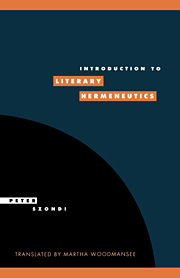Book contents
- Frontmatter
- Contents
- Foreword by Joel Weinsheimer
- Translator's preface
- Chapter 1 Introduction
- Chapter 2 Chladenius, I
- Chapter 3 Chladenius, II
- Chapter 4 Chladenius, III
- Chapter 5 Chladenius, IV
- Chapter 6 Meier, I
- Chapter 7 Meier, II
- Chapter 8 Ast
- Chapter 9 Schleiermacher, I
- Chapter 10 Schleiermacher, II
- Afterword by Jean Bollack
- Index
Chapter 6 - Meier, I
Published online by Cambridge University Press: 14 December 2009
- Frontmatter
- Contents
- Foreword by Joel Weinsheimer
- Translator's preface
- Chapter 1 Introduction
- Chapter 2 Chladenius, I
- Chapter 3 Chladenius, II
- Chapter 4 Chladenius, III
- Chapter 5 Chladenius, IV
- Chapter 6 Meier, I
- Chapter 7 Meier, II
- Chapter 8 Ast
- Chapter 9 Schleiermacher, I
- Chapter 10 Schleiermacher, II
- Afterword by Jean Bollack
- Index
Summary
It is one of the aims of a critical examination like the one we are pursuing here, in lieu of a purely historical presentation or a new hermeneutics, to reveal the historical determinateness of hermeneutic theories. The traditional notions of Enlightenment hermeneutics, to which the philological and theological contemporaries of Weimar Classicism and German Idealism formulated a counterposition, appear in another hermeneutic theory from the mid-century which differs from Chladenius' work on important points despite their common descent from the philosophy of Leibniz and Wolff. This is Versuch einer allgemeinen Auslegungskunst [Toward a General Theory of Interpretation] (1757) by Georg Friedrich Meier, who lived from 1718 to 1777 and was professor of philosophy in Halle. A disciple of Wolff's disciple Alexander Gottlieb Baumgarten, the author of the Aesthetica, Meier published Anfangsgründe aller schönen Künste und Wissenschaften [Basic Premises of All the Fine Arts and Sciences] in 1748, which earned him the name of co-founder of German aesthetics. Among his works a Metaphysik (1755–59) and a Vernunftlehre [Theory of Reason] (1752) ought also to be mentioned. At the time, all of these works were more highly regarded than the Versuch einer allgemeinen Auslegungskunst; and even histories of hermeneutics, owing undoubtedly to their theological or philosophical bias, have not paid it the attention it deserves. Not until Lutz Geldsetzer arranged for a new printing in 1965 did Meier's Auslegungskunst again become accessible and reenter discussion.
- Type
- Chapter
- Information
- Introduction to Literary Hermeneutics , pp. 67 - 79Publisher: Cambridge University PressPrint publication year: 1995

